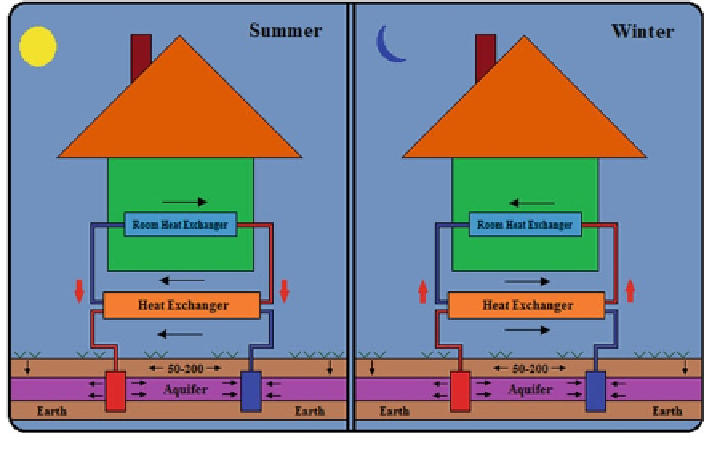Civil Engineering Reference
In-Depth Information
Fig. 4
Schematic representation of the ATES system
During summer cooling mode, the ATES system retrieves the cold energy
contained by the underground water (that is available around 8-10 C) through the
extraction well. The cold energy is then transferred to the heat exchanger unit
coupled with the building thermal zone. The warm return water from the heat
exchanger is then routed back into the underground water layers through the
injection well.
There are essentially three types of ATES systems capable of storing heat or
cold depending on the thermal load demand in buildings. They are single (mono)-
source, double-source (doublet) and recirculation (year-round) ATES systems.
Depending upon the constructional aspects related to extraction well, injection
well, heat exchange mechanism, flow direction of heat transfer fluid, etc., these
systems are preferred for the medium- to large-scale TES applications in buildings.
It is noteworthy that the ATES systems can achieve thermal storage capacity up
to 15 kWh/m
3
(Lemmens et al.
2007
). The coefficient of performance (COP) (the
ratio of net cooling or heating effect to the electrical power input) of the ATES
systems varies between 15 and 35, if the processes occur by natural cooling. At the
same time, ATES systems if combined with a conventional chiller plant, the COP
can be expected to achieve around 3.5-4.0 for a temperature gradient of 6-7 C
between the supply and return chilled water mains.
Similarly, the ATES integrated with a heat pump system is able to accomplish
the COP ranging from 4.5 to 6.5 during heating process. ATES system also offers
low operational and maintenance costs on a long-term basis and has a life
expectancy of around 20-25 years.

